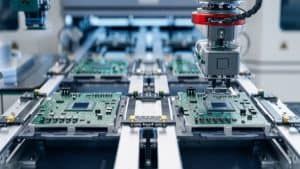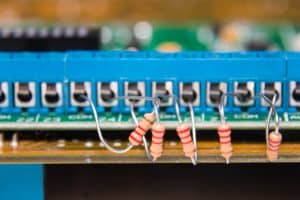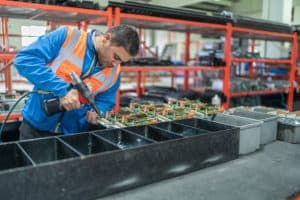Developing a good understanding of the printed circuit board technical terms can make your partnership with a PCB assembling company much better and easier. This guide presents a list of the technical terms frequently used in the PCB industry to familiarize you more with our products and services.
Though this is not an all-inclusive list, it will act as a good reference point.
55 Technical Terms Frequently Used in the PCB Industry
1. AC – Alternating Current
A current that occasionally reverses direction and alters its magnitude continuously with time in contrast to direct current (DC) that flows only in a single direction. AC is the form in which power suppliers deliver electricity to businesses and residences for use.
2. Annular Ring
The copper pad area left after drilling a hole through it. Basically, you measure this ring from the pad edge to the hole edge. An annular ring is an essential parameter in printed circuit board design, as it facilitates electrical connections from one part of the hole to the other.
3. Anti-solder Ball
A common technique used in SMT production lines to minimize the amount of tin applied in the stencil process. This is achieved by creating a stencil on a board and drilling holes where the solder ball is formed so that the tin paste flows to the holes.
4. AOI – Automated Optical Inspection
This is an automatic visual inspection method used to test defects in printed circuit board assembly (PCBA). AOI autonomously examines the PCBA process for catastrophic and quality failures.
5. AQL – Acceptance Quality Limit
This is the acceptable number of defective PCBs produced in a given production run. These boards are later selected, numbered and removed during the AOI process.
6. AVL – Approved Vendor List
A compiled list of vendors and suppliers vetted and approved by a company as reliable sources for component sourcing.
7. BGA – Ball Grid Array
A type of surface-mount packaging applied in integrated circuits. You can use BGA packages to mount components, like processors, permanently. They have more interconnection pins that are useful in dual in-line and flat packages.
8. Bare Board
This is a printed circuit board with conductors but lacking electronic components. It comprises a substrate, metal coating, conductive pathways and patterns.
9. Blind Via
An electroplated hole that starts from the PCB surface, connecting an external layer with one or more internal layers. This is why you can only see blind vias on one PCB side. These vias are useful when you lack adequate space on your board’s lower or upper part or when you cannot make a hole on one side because it is fully packaged.
10. BOM – Bill of Materials
A comprehensive list of the raw materials, assemblies, subassemblies, components, and quantities of each, required in PCB manufacturing. A BOM is normally written in a hierarchical format, with the highest level describing the end product and the bottom level highlighting individual components and materials.
11. Buried Via
An electroplated hole that links two or more internal layers. A blind via cannot be seen from the outside. These vias are drilled and plated before board pressing. Blind vias enable more functionality in densely populated boards.
12. CAD – Computer-Aided Design
CAD uses computers to assist in creating, modifying, analyzing, and optimizing a design. The CAD software increases the designer’s productivity, enhances the quality of design and communications through documentation. Designs created through CAD software help in protecting inventions when applying for patents.
13. CAM – Computer-Aided Manufacturing
Like CAD, CAM involves the application of computers in the PCB manufacturing process. It facilitates the application of software to enhance production. Basically, the CAM software translates data and drawings into readable instructions for machines to process raw materials into finished products.
14. CAM Files
These are files produced by CAM software to help in PCB manufacturing. There are several CAM files, such as Gerber files for photoplotters and NC Drill files for NC Drilling equipment.
15. COB – Chip-on-Board
A PCB manufacturing method where integrated circuits are wired, fused directly to the board, and sealed by an epoxy blob. By bypassing the packaging of single semiconductor components, the finished product is denser, lighter, and more cost-effective. Besides, the COB method enhances the operation of radio-frequency systems by minimizing the inductance and capacitance of integrated circuits.
16. Circuit
A closed path which enables electric current to flow from one point to another. A circuit may comprise electrical components, like transistors, resistors, and capacitors, but the flow is uncontrolled by breaking the circuit.
17. Coating
In the electronic world, a coating is a continuous solid film covering a wire or PCB. Although there may be physical benefits of coatings, their main function is to provide greater optical and electrical properties to electronic parts.
18. Components
Also referred to as electronic components. These are basic parts used to build electronic devices. Some of the common electronic components include resistors, capacitors, valves, radiators, etc.
19. Cutout
A switch that disconnects a circuit after other factors have interjected the current.
20. DC – Direct Current
An electric current that is uni-directional; thus, the flow of charge is usually in the same direction. Unlike alternating current (AC), the direction and amperage of a DC remain constant. You can easily convert a DC to an AC using an inverter.
21. DIP – Dual In-Line Package
An electronic housing package for integrated circuits. It contains a rectangular housing (mostly a shaped plastic container) and two rows of electrical connector pins.
22. DNC – Distributed Numerical Control
A network that facilitates the connection between one remote computer and one or more CNC computers. With DNC, you can load CNC programs into other equipment, update and modify them, and remove or replace them with others.
23. Double-sided PCB/Two-Layer PCB
A printed circuit board containing conductive copper layers on both sides – the top and bottom layers. It is essential in most electronic devices since circuits on the top layer can be connected to the bottom layer by simply drilling holes on the PCB.
24. DRC – Design Rule Check
A software verification process for checking whether there are any defects with the PCB layout. Before embarking on any production, it is important to check PCB designs and ensure no defects, like small drill holes. Basically, you need to carry out design rule checks to verify if your designs meet the manufacturing standards.
25. Dry Film Solder Mask
A film mask applied to a PCB to achieve a higher resolution mask with finer line designs. However, this method is a bit more expensive than other methods, like liquid solder mask.
26. DUT – Device Under Test
Basically, this is a product that is currently being tested. Mostly, this takes place before the product is packaged for sale or after repair. Still, it can be a prototype that is being tested until it breaks or fails.
27. ERP – Enterprise Resource Planning
A software system for handling most elements of manufacturing or distribution enterprise. ERP systems are classified into modules like Financials, Sales, Purchasing, Inventory Management, Manufacturing, MRP, and DRP. These modules designed to integrate well with other systems and offer a consistent user interface.
28. ESS – Environmental Stress Screening
This is another method of ensuring quality by passing end products through stress-testing. ESS is a series of environmental tests that strive to detect errors and weaknesses that can cause catastrophic failures. Usually, manufacturers conduct temperature variations, pressure, vibration, and flexibility tests.
29. Fabrication Drawing
Designers use fabrication drawings to communicate to engineers and other workers easily. A fabrication drawing contains PCB illustrations, location and information about apertures to be made, laminate information, the applicable methods, etc.
30. FR4 – Flame Retardant 4
This is a common insulation material for making PCBs. It is made of woven glass fibres (fibreglass), which are epoxied together. FR4 glass epoxy is a common and versatile high-pressure thermoset plastic laminate grade with high strength to weight ratios.
31. Gerber File
A Gerber file is the most common and widely used file format in the PCB industry. It is an open ASCII format file containing information on every PCB component of your design. PCB components, such as copper traces, vias, pads, solder mask, and silkscreen images, are characterized by a drawing code and defined by various vector coordinates. PCB manufacturers use Gerber files to translate designs into the physical properties of a board.
32. HASL – Hot Air Solder Leveling
A surface finish process where a thin layer of solder is applied as a protective cover on the exposed copper parts. HASL is the cheapest surface treatment and is the common surface finish in most PCB fabrications. Though some systems can deposit a fairly uniform coating, this method leaves a rough surface compared to other methods, like ENIG.
33. HDI – High-Density Interconnect
HDI circuits have a higher wired density per unit area – they have more compact parts arrangement. Because of their lightweight, HDI PCBs are widely applied in the aerospace and smartphone industries.
34. IPC – Institute of Printed Circuits
A global non-profit making organization dedicated to PCB design. The organization supports businesses to achieve better business success by assisting them to meet stringent quality manufacturing standards.
35. JEDEC – Joint Electronic Device Engineering Council
A non-profit organization representing the microelectronics industry. It acts as a regulatory watchdog and a communication network. Since its establishment in 1958, JEDEC has acquired a huge following, including leaders from the biggest computer companies in the world.
36. Laminate
A combination of various materials via heating, adhesive and welding processes forms a new material with several layers. The end product (laminate) is stronger and more stable than the individual materials used to create it.
37. Laser Direct Imaging
While the standard imaging techniques require a photo device to transfer images, Laser Direct Imaging has a computerized, highly focused laser beam that directly projects the circuit path onto the PCB. The elimination of a photo device gets rid of alignment and light refraction issues.
38. LPI – Liquid Photoimageable
An ink produced by photographic imaging methods to regulate deposition. LPI stands out as the most accurate mask application method that leaves a thinner mask than other methods. For this reason, it is often applied in dense SMT.
39. MES – Manufacturing Execution System
An information system that controls and tracks the PCB manufacturing process. MES ensures that all the processes are effectively conducted, improving production output. This is achieved by tracking and collecting real-time and accurate information from every production line.
40. NPI – New Product Introduction
This is the process of creating an effective plan to turn your ideas into products. NPI steps vary from one project to another, but the ultimate objectives are the same: minimize waste, eliminate miscommunication, accelerate production, and save money. You should create a clear NPI plan and collaborate with engineers and the support team for your project to be successful.
41. Multilayer PCB
A circuit board with more than two conductive copper layers. They look like several layers of double-sided PCBs, laminated and glued together with layers of heat-protective insulation between them. The construction of a multilayer PCB is designed so that two layers are located on the surface sides of the board to connect to the environment.
42. NPTH – Non-Plated Through Holes (NPTH)
A non-plated through-hole has no copper plated onto the hole walls; thus, the barrels lack electrical properties. NPTHs were commonly used when PCBs only contained copper tracks printed onto one side. However, their application reduced with the increase for more PCB layers.
43. OEM – Original Equipment Manufacturer
This is a company that produces and sells products or components that buyers, other companies sell to their clients while placing the products or components under their own branding. For example, HP laptop components are not all manufactured by HP. Some parts, such as the motherboard, maybe OEM products.
44. OSP – Organic Solderability Preservative
A PCB coating method that uses a water-based organic compound to bind copper, protecting it until soldering selectively. The compounds commonly used in this method are the azole family, such as benzimidazoles.
45. PCB – Printed Circuit Board
A PCB provides mechanical and electrical support to electronic parts using conductive tracks, pads and other features etched from copper layers. PCBs are found in almost every electronic device, and they can be single-sided, double-sided, or multilayered.
46. PCBA – Printed Circuit Board Assembly
A process of linking the electronic parts with the wirings of a bare circuit board. The conductive pathways etched in the laminated PCB copper layers are used in a non-conductive substrate to create the assembly. Connecting components to a bare board is the concluding activity towards obtaining a fully operational electronic gadget.
47. RF – Radio Frequency
The oscillation rate of an AC, voltage, or magnet in the frequency range of between 20 kHz to 300 GHz. Generally, this is between the higher limit of audio frequencies and the lower limit of infrared frequencies.
48. RoHS – Restriction of Hazardous Substances
This is a set of standards originally put in place by the European Union in 2002 to regulate engineering aspects for exports and imports. RoHS compliant electronics adhere to the allowable amounts of these six hazardous substances: lead, mercury, cadmium, hexavalent chromium, polybrominated biphenyls (PBB), and polybrominated diphenyl ethers (PBDE).
49. Reflow Soldering
A process where solder paste is applied to temporarily mount small electrical parts to their contact pads before exposing the whole assembly to regulated heat. The solder paste reflows in a molten state, forming permanent solder joints. Heating is done by passing the assembly through a reflow oven, an infrared lamp, or soldering single joints with a desoldering hot air pencil.
50. Schematic
A technical drawing that shows the connections between PCB parts. A schematic often contains abstract representations of parts instead of images and is a primary ingredient in PCB design.
51. Silkscreen
A layer of epoxy ink applied to a circuit board that bears components labels and positions. The labels guide engineers throughout the assembling process. Normally, silkscreens are white, distinguishing the labels from the solder mask.
52. SMT – Surface Mount Technology
A mounting technique where parts are mounted directly onto the PCB surface. SMT facilitates high production automation, reducing the production cost and improving the quality of products. The electrical parts placed using SMT are known as Surface-Mount Devices (SMD).
53. Substrate
This is basically a PCB base material – the main material for printed circuit board fabrication. A substrate can be flexible or rigid and can contain epoxy, metallic, or ceramic properties. The PCB application normally determines the type of substrate to use.
54. Surface Finish
A surface finish is applied to copper layers to prevent oxidation from taking place. Oxidation makes the tin paste fail or solder inappropriately. There are several types of surface finishes, like HASL, ENIG, IMAG, OSP, and others.
55. Vias
These are the plated through-holes that transmit signals from traces to various PCB layers. These holes contain conductive copper interiors to facilitate electrical connections.
Conclusion
While we have not exhausted every PCB technical term, the above list contains all the basic terms that you need to have at your fingertips.
MKTPCB is a professional and reliable one-stop PCB service provider from Shenzhen, China. We provide various PCB products and services at cost-effective prices and short turnaround times. Kindly contact us today to learn more about our products and services.











